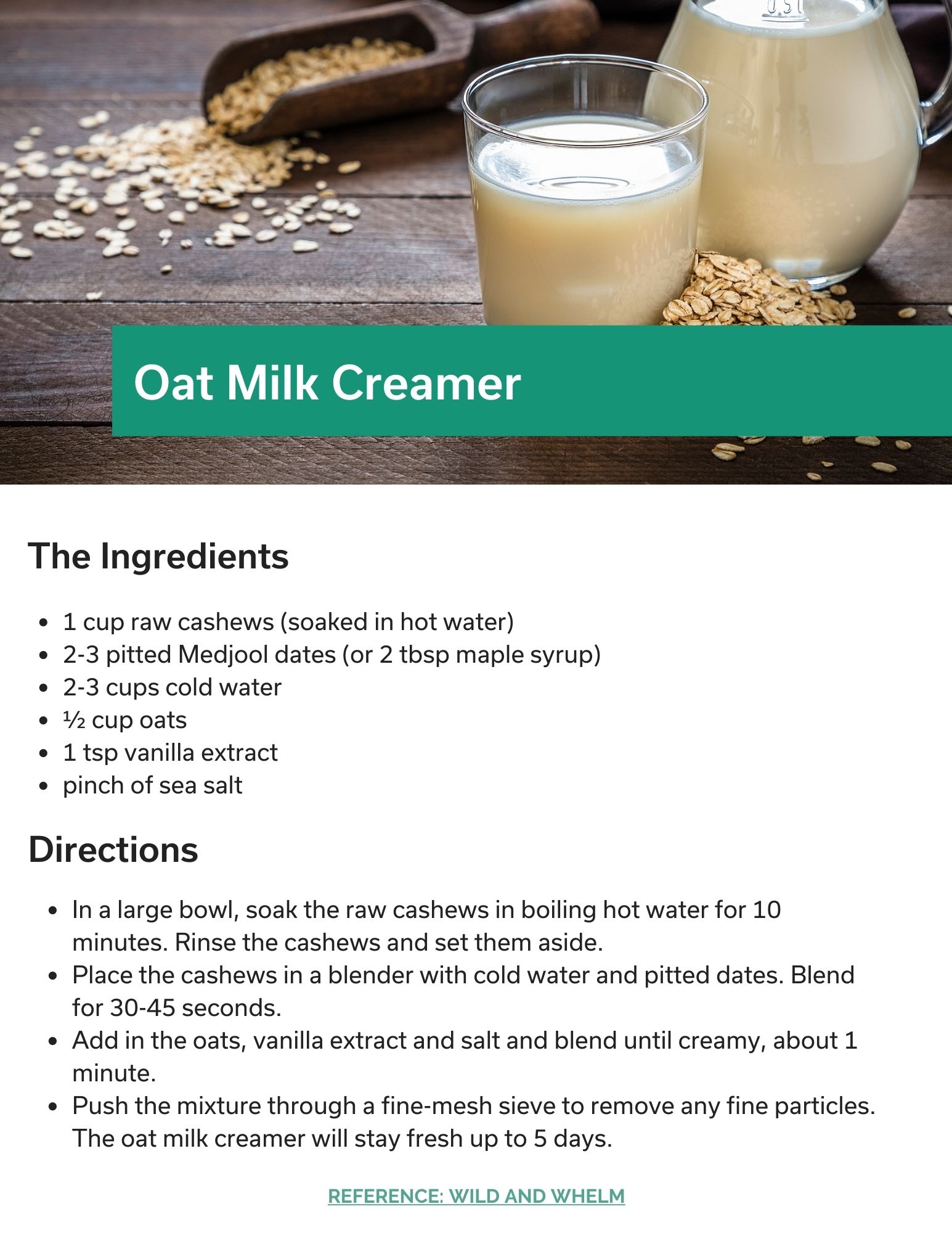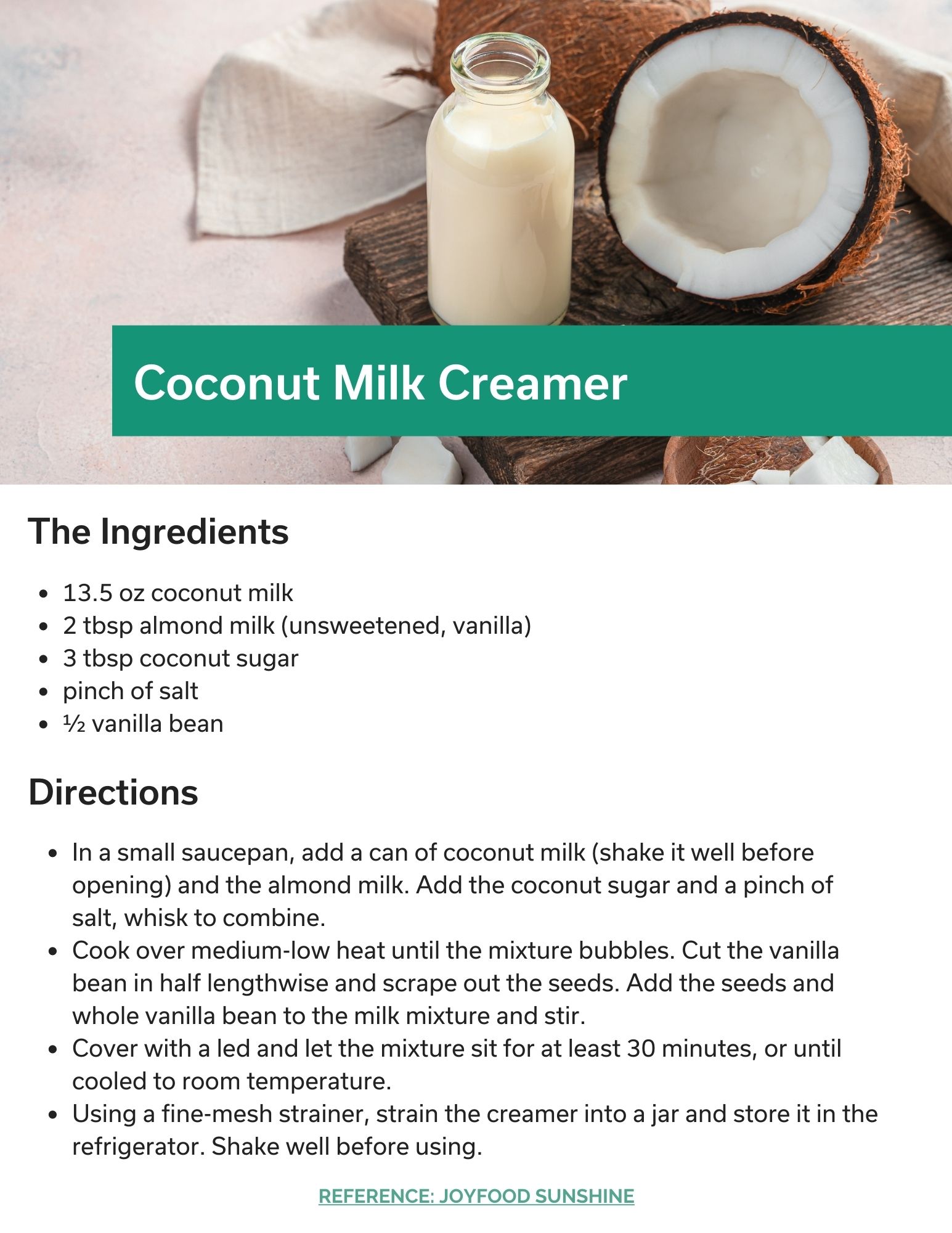Are Plant-Based Coffee Creamers Healthier?
Posted in

These days, most of the milk or creamers in the dairy section don’t even contain any dairy. That’s because plant-based creamers are on the rise. What’s all the fuss about, though? Are they really that much healthier than half-and-half or heavy cream? We answer these questions and offer ways to make your own plant-based creamers at home.
The difference between dairy, non-dairy creamers and dairy-free creamers
For the coffee purists, there are two traditional creamer options when it comes to your morning cup of joe: heavy cream or half and half.
Why? A non-dairy creamer is a bit of an oxymoron; it’s not a creamer if it doesn’t contain cream. However, the word “creamer” is used to describe the purpose of the product as opposed to the ingredients. Creamers mimic cream or half-and-half by enhancing coffee’s flavor and making it creamier.
Still, packaging for any type of consumer product can be confusing. The same goes for coffee creamers. You may see the words “coffee creamer,” “non-dairy creamer” or “dairy-free creamer” at your local grocery store and not understand how they’re different.
Dairy
Dairy-based creamers have been staples for coffee drinkers for decades. Most people use half-and-half, while others use a splash of cream. Cream is made from the butterfat that is extracted from milk. Cream contains at least 36% milkfat. Half-and-half is a combination of cream and milk.
Dairy-free coffee creamers
Plant-based creamers fall under the dairy-free category, meaning they are free of dairy, lactose and any other milk derivatives. These vegan products usually originate from nuts, grains or soy products and are mixed with water and other additives to create a creamy texture. To add to the confusion, some dairy-free products may still be marketed as such, yet they contain sodium caseinate or micellar casein, two milk proteins used in foods. How can manufacturers label it as dairy-free then? Under FDA guidelines, they consider milk derivatives dairy-free and lactose-free.
Non-dairy coffee creamers
Non-dairy creamer typically confuses consumers because most people think non-dairy means the product doesn’t contain dairy. Many non-dairy creamers still contain sodium caseinate, a protein derived from cow's milk. Sodium caseinate helps whiten products so they resemble heavy cream or half-and-half. They also contain oils and glycerides for texture. Powdered non-dairy creamers contain corn syrup solids, oils and sodium caseinate.
Coffee creamer alternatives
What’s the difference between plant-based milk and plant-based creamer, you may ask? In general, creamers are more concentrated than plant-based milk so you only need a tablespoon or two when using it in your coffee.
For example, coconut milk is a mixture of coconut cream and water, while coconut creamer uses just the coconut cream to make a more concentrated product – more fat equals a thicker consistency that resembles heavy cream. The distinction is the same when comparing oat milk and oat creamer – water and oats are blended then strained. The lone exception: Oat creamer is highly concentrated.
Types of vegan coffee creamers
Oat milk creamer: Oat milk itself can tend to be on the watery side, but concentrated oat milk creamer provides a thicker consistency more similar to half-and-half.
Almond milk creamer: Almond milk creamer is one of the more watery vegan creamers you can buy, but it’s low in fat and offers a slightly nutty flavor profile. Almond milk is usually mixed with other plant-based products to improve the consistency.
Coconut creamer: Since coconut cream is both thicker and creamier than coconut milk, it makes for a good substitute to heavy cream or half-and-half. However, because coconut cream is high in saturated fat, many vegan coffee creamers use coconut cream with a blend of other plant-based milks, such as oat, almond or soy.
Soy milk creamer: Soy-based creamers offer a smooth, slightly sweet flavor, but they tend to be on the watery side and can separate when added to coffee.
Cashew milk creamer: While not as popular as other tree nut creamers, cashew milk creamer has a thicker consistency than almond- or soy-based creamers without the sweetness of coconut creamer.
Banana milk creamer: One of the more recent additions to the marketplace, banana puree usually pairs up with coconut milk and almond milk to add flavor and added nutrients. On its own, mixing these three ingredients together makes for an unnatural consistency, so gums are added to improve the consistency and texture.
Pea milk creamer: Pea milk tends to have more protein than other plant-based creamers, but this benefit is negligible since most people only use a tablespoon or two of it in coffee.
Macadamia milk creamer: Also newer to the market, macadamia milk is similar from a nutritional standpoint to almond or cashew creamers in that it contains healthy monounsaturated fats. This creamer is often combined with coconut cream to boost the texture.
Hemp milk creamer: This type of creamer tends to be on the thinner side because it uses hemp seeds blended with water. It has a neutral taste, though, which makes it an attractive option for people who don’t want an overpowering creamer.
What’s in coffee creamers?
The main turnoff of coffee creamers found in your workplace break room stems from an exhaustive list of processed ingredients – corn syrup, vegetable oil, stabilizers, additives, sugars and flavorings.
Here is a glimpse of the ingredients you can find in most non-dairy coffee creamers, both liquid and powder varieties.
- Vegetable oil: A common ingredient in powdered coffee creamer, vegetable oil helps mimic the creaminess usually found in heavy cream. Some creamers use hydrogenated vegetable oils that require extensive processing. Other products may contain palm oil, a type of saturated fat.
- Sugar or sweeteners: Cane sugar is the most common added sugar in coffee creamers, although some use zero-calorie sweeteners such as stevia.
- Thickeners: Non-dairy creamers and even plant-based creamers lack the thickness of heavy cream. Carrageenan and lecithin, two common additives in creamers, help emulsify watery liquids into thicker products. Lecithin is a common thickener for nut milk creamers.
- Binders: You’ll also usually find a “gum” of some sort on the label of your favorite coffee creamer. For example, gellan gum, xanthan gum, locust bean gum and other gums help bind vitamins and minerals to liquids so they don’t separate.
- Stabilizers: One of the most common stabilizers, dipotassium phosphate, is used as a buffering agent, flavor enhancer and preservative. Calcium carbonate and lecithin also serve as a stabilizer.
- Natural flavors: The ingredient “natural flavor” is a generic term that describes any essential oil or extract (either plant or animal based) that flavors food. plant-based animal source. Some creamers even contain monosodium glutamate, a popular flavor enhancer found in restaurant foods (such as Chinese takeout) and other processed products.
What about plant-based coffee creamers?
While often viewed as a healthier option, plant-based creamers aren’t immune from added ingredients to make them taste better or remain stable for consumption.
Many vegan coffee creamers still contain ingredients such as sunflower lecithin, dipotassium phosphate, gellan gum, locust bean gum, calcium carbonate, Some still contain processed oils, added sugars and stabilizers.
Why? For example, nut milks, such as almond milk, tend to separate naturally when protein and carbs break apart. While you can shake the product before using it, many food manufacturers simplify this step by adding ingredients to avoid separation.
Even coffee creamers with minimal ingredients still contain dipotassium phosphate and calcium carbonate to stabilize the mixture. In addition, calcium carbonate also serves as a natural food color to give creamers their distinct white hue.
Are there health benefits?
Plant-based creamers may be beneficial if you’re trying to limit calories. Here is an overview of how each type of creamer stacks up:
- Non-dairy creamer: 10 to 20 calories per tablespoon
- Plant-based creamer: 10 to 25 calories per tablespoon
- Half-and-half: Around 40 calories per tablespoon
- Heavy cream: Around 50 calories per tablespoon
As you can see, you can save as much as 100 calories per day if you drink two to three cups of coffee.
In addition to saving on calories, many plant-based creamers are low in sugar or contain no added sugars. Half-and-half and heavy cream don’t have any added sugars, but the natural sugars from lactose (milk sugar) can still add up. Some plant-based creamers use cane sugar as a sweetener, although you can buy unsweetened versions.
The same goes for saturated fat. Cow’s milk contains saturated fat, while many plant-based creamers are free of this type of fat. Coconut creamers are one of the few exceptions. If saturated fat is a concern, try soy- or almond-based creamers.
What to look for
Nutritional information aside, all non-dairy creamers aren’t equal. Some products use nearly a dozen ingredients in their recipes, including oils and some additives that you’ve never heard of.
If you’re going to buy a plant-based product, look in the refrigerated section. Some plant-based creamers are found on shelves due to the presence of additives and preservatives to keep them shelf-stable.
As with any other product, the fewer ingredients the better. Always check the label for added sugars. Some flavored creamers can have 5 grams of added sugar or more per serving.
Don’t be afraid of trying newer products, either. For example, there is a pistachio milk creamer that uses rice as a thickener. The only other ingredients include a small amount of cancer sugar, salt and dipotassium phosphate (for flavor and preservative).
Making coffee creamer at home
You may be tempted to add a splash of oat milk or almond milk to your coffee, but the consistency of most plant-based milks pales in comparison to coffee creamers. That said, plant-based creamers can be expensive, making it more affordable to make your own versions at home. Plus, you can limit the additives and hard-to-pronounce ingredients.
How to make oat milk creamer
This homemade oat milk creamer uses cashews to thicken and emulsify the mixture without using additives. The addition of dates also adds a subtle sweetness.
Almond milk creamer recipe
On its own, almond milk can be watery, so adding macadamia nuts provides a richer, more suitable texture for coffee. The high fat content of macadamia nuts makes it ideal to froth for a latte.
Coconut creamer milk recipe
Coconut milk is high in saturated fat, so a little goes a long way. Add a few tablespoons of almond milk helps round out the flavor, keep the mixture smooth and prevent it from turning to a solid when refrigerated.
Visit the INTEGRIS Health For You blog for more lifestyle, wellness and health content.






